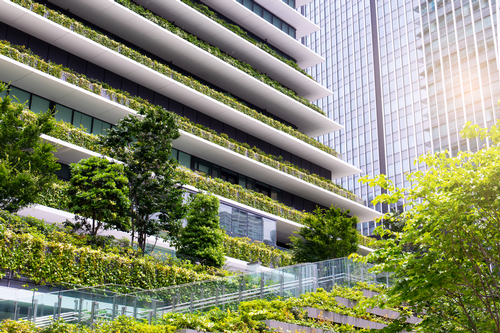WEDNESDAY, MAY 10, 2023
Starting in 2026, the state of New York reportedly plans to require a ban on fossil fuel equipment in the construction of new buildings. While currently a proposal and not finalized, the replacement is recommended in the state’s climate plan.
Politico reports that the state’s budget will implement the ban in most new buildings under seven stories starting in 2026, with larger buildings covered in 2029. This includes propane heating and no gas furnaces or stoves in most new construction. Exemptions will be included for commercial kitchens, emergency generators and hospitals.
“Just like we had to, a long time ago, transition from coal as your energy source, we do have to transition. There are clean energy alternatives,” New York Governor Kathy Hochul said in an interview with Good Day New York.
“New buildings that are going up—they can go electric, they can do heat pumps. This is how you transition. Nobody's touching your gas stove.”
New York would reportedly be the first state to take this step through legislative action; California and Washington have previously done so through building codes. The measure will help the state achieve its ambitious mandate to cut emissions by 40% from 1990 levels by 2030 and 85% by 2050.
The rule is also anticipated to align with New York City’s zero-emission building law that passed in 2021. The later date—starting Dec. 31, 2028—is also expected to apply for commercial buildings and those over 100,000 square feet, Hochul spokesperson Katy Zielinski said.

 |
| t_kimura / Getty Images |
|
Starting in 2026, the state of New York reportedly plans to require a ban on fossil fuel equipment in the construction of new buildings. |
Previous NYC Actions
Back in March 2020, New York City announced that it would be requiring that all new and existing buildings to meet stricter energy efficiency requirements under a new energy code approved by city council and passed by then-Mayor Bill de Blasio.
The 2020 NYC Energy Conservation Code ensured that buildings—the city's biggest polluters—are held to the highest standard of sustainability and efficiency. While the Energy Conservation Construction Code required several mandates, many focused on building envelopes, and was just of the construction codes being updated by the Department of Buildings as a part of the Code Revision Cycle at the time.
In December 2021, the New York City Department of Buildings announced the official passage of major legislation in the City Council to update the city’s Construction Codes with the aim of keeping the city on the forefront of building safety and innovation.
According to the DOB, there were more than 600 revisions and changes being made to the city’s codes. Most of the updates were slated to go into effect the next year, with some updated regulations slated to have taken effect on Jan. 1, 2022.
In deciding on what revisions to make to the city’s codes, technical committees used the highest international standards for the design, construction and maintenance of buildings as a baseline. The committees were reportedly composed of engineers, architects, attorneys, planners, tradespeople, representatives of the construction industry, labor, real estate industry and utility companies, as well as DOB and interagency stakeholders.
Although updated regularly regarding construction in both new and existing buildings, the latest slew of changes are the first holistic update to the entire set of NYC Administrative, Plumbing, Building, Mechanical and Fuel Gas Codes since 2014.
Code revisions are slated to be made to emergency response, fire protection, vertical transportation and accessibility, elevator and boiler safety, tenant protections, building occupancy, affordable housing, construction safety and building system construction and inspection enhancements.
Building Performance Standards Coalition
In January of last year, President Joe Biden announced that his Administration would be launching a Building Performance Standards Coalition dedicated to delivering cleaner, healthier and more affordable buildings.
The coalition is reportedly a first-of-its-kind partnership between 33 state and local governments, in addition to the states of Colorado and Washington, and builds upon the Department of Energy’s efforts to upgrade one million homes.
The progress made by the coalition will also aid President Biden’s efforts to retrofit four million buildings and two million homes during his first term.
According to reports, the coalition plans to outline new commitments to design and implement building performance standards at the state and local level, create good-paying, union jobs, lower energy bills for consumers, keep residents and workers safe from harmful pollution and cut emissions from the building sector.
The actions build on the $3.5 billion investment for home weatherization in President Biden’s Bipartisan Infrastructure Law—which will make 700,000 homes more energy efficient and lower consumers’ electricity bills—and will make $1.8 billion available to expand building retrofits and policy implementation.
The White House reports that the New Buildings Performance Standards Coalition is supported by labor unions, philanthropy and non-governmental organizations. All those involved plan to come together to scale programs and policies to reduce emissions across the building sector.
Other actions made to strengthen building performance standards include:
Nearly 20% of the nation’s building footprint is located within the partnering jurisdictions, according to The White House. A full list of governments in the partnership include: the state of Colorado; state of Washington; Ann Arbor, Michigan; Annapolis, Maryland; Aspen, Colorado; Atlanta; Boston; Cambridge, Massachusetts; Chicago; Chula Vista, California; Columbus; Denver; Evanston, Illinois; Fort Collins, Colorado; Grand Rapids, Michigan; Ithaca, New York; Kansas City, Missouri; Los Angeles; Milwaukee; Montgomery County, Maryland; New York City; Orlando, Florida; Philadelphia; Pittsburgh; Portland, Oregon; Prince George’s County, Maryland; Reno, Nevada; Sacramento, California; St. Louis; San Francisco; Savannah, Georgia; Seattle; and Washington, D.C.
The ultimate goal of the coalition is to advance legislation or regulation in each of the committed jurisdictions by April 22, 2024.
Tagged categories: Building codes; Certifications and standards; Construction; Emissions; Environmental Controls; Good Technical Practice; Government; Green building; Laws and litigation; New Construction; Oil and Gas; Program/Project Management; Projects - Commercial; Regulations